A Buddhist Scrooge
Charles Dickens and the Universal Spirit of Christmas
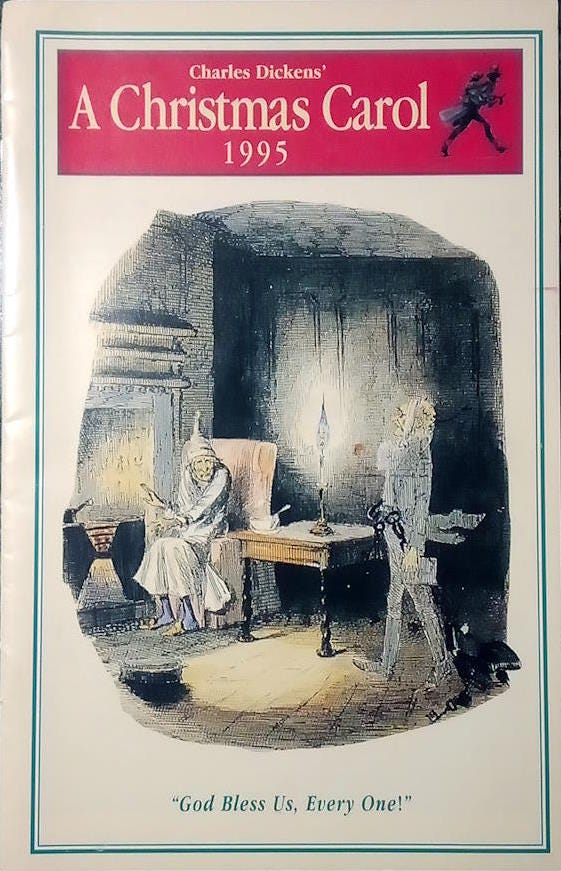
Dear Living Dark readers,
Today, I share with you a Christmas memory from my personal past that has remained alive within me for thirty years. It involves my time at The Glen Campbell Goodtime Theater in Branson, Missouri, where I directed the live video portion of Glen’s music shows for two years in the 1990s. It further involves the actor John Astin, whose memorable presence has wound its way through many of the movies and television shows that have populated my personal experience—and also probably your own—since earliest childhood. Finally, it involves Charles Dickens’s A Christmas Carol, a book and a story that has likewise been dear to me from an early age. All these things came together for me when Mr. Astin said to me personally, at Glen’s theater, one of the most insightful things I ever heard anyone say about the universal spiritual appeal of Dicken’s classic story.
Here’s what happened:
In December 1995, the last thing I ever did at Glen’s theater before I left to work as a video and media producer at Missouri State University in nearby Springfield was to participate in a touring musical production of A Christmas Carol that came to Branson and landed at Glen’s theater for a week-long run. This represented a stark departure from my normal duties, which involved directing a camera crew to produce the live video images that played on the IMAG (image magnification) screens above the stage for Glen’s twice-daily performances, and also for shows by the likes of The Oak Ridge Boys and Eddie Rabbitt. The owners of Glen’s theater allowed the traveling play to use local crew members as stagehands, so this meant that, after a quick group meeting with the show’s costume director, I and my fellow theater employees were soon fitted with properly nineteenth-century-looking Dickensian costuming and placed onstage to move around stage flats for scene changes during the performances.
Fascinatingly, the actor filling the lead role of Ebenezer Scrooge was none other than John Astin. This fairly blew my mind. If you’re not familiar with John Astin, be aware that he played Gomez Addams in the old Addams Family TV series. And The Judge in Peter Jackson’s The Frighteners. He has also appeared in West Side Story, National Lampoon’s European Vacation, the original Twilight Zone, the original 1976 Freaky Friday, Night Gallery, Night Court, and a host of additional movies and TV shows. He’s also the father of Sean Astin, who today carries on the Astin family acting legacy. In Branson, it turned out that John had succeeded Wilford Brimley—another huge name from my movie and television past—in the role of Scrooge after Brimley had toured with the same drama company a couple of years earlier.
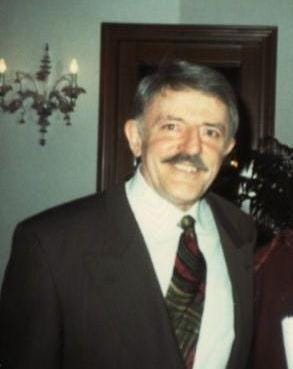
My time in Branson had already seen me working with or around multiple celebrities, including Kenny Rogers, Barbara Mandrell, Vince Gill, Billy Ray Cyrus, Garth Brooks, and even many stars from outside the country music wing of the show business industry, such as Gladys Knight, the Everly Brothers, the Smothers Brothers, and Doc Severinsen. But John Astin was the first celebrity actor to enter that milieu (unless you count Kenny Rogers with his multiple television movie appearances, or maybe Glen himself with his classic 1960s television variety show plus his famous turn as the Texas Ranger La Boeuf opposite John Wayne in 1969’s True Grit).
The fact of my temporary place on the stage crew for this play meant I got to be around Mr. Astin quite a bit, especially during one scene in the play where the blocking had him duck behind a piece of scenery that was under my responsibility and then stay there with me there in the shadows for a few minutes. But there was no chance to try and converse with him during those moments, since the show was underway. Still, it was quite a trip to be crammed back there with him, wondering how in the world life had led me to such a singularly interesting experience.
But then, on maybe the third or fourth night of the play’s six-day schedule, a chance arose for me to actually speak with him. Or actually, it didn’t just “arise”; I deliberately manufactured it. Specifically, I took advantage of Mr. Astin’s practice of taking up a spot at an autographing window on the floor next to the stage after each show, still dressed in full Scrooge makeup and costume, so that he could greet the audience members who came streaming by on their way to the exit. He appeared to enjoy this part of each evening’s show immensely, though in a kind of quietly half-shy way that I found intriguing. And on the night in question, I positioned myself last in line and thus created an opportunity to meet him formally and, I hoped, discuss Dickens’s classic Christmas story with him.
At this point I should pause to mention that A Christmas Carol is one of my favorite novels. I first read it as a teenager and then, in my twenties and thirties, made a ritual practice of rereading it every December. I have watched and rewatched a dozen or more of its movie and TV adaptation, with the 1984 version starring George C. Scott in the lead role as my favorite, and with 1970’s Scrooge, starring Albert Finney, coming in a close second. For six years in the early 2000s I taught the novel to high school students. So this is all to say that Dickens’s classic Christmas ghost story of a cruel-hearted miser’s redemption has occupied an important place in my affections for many years, and this was already the case back in 1995 when that touring musical play came to Branson. In fact, on the night when I maneuvered to speak with John after the show, I was already engaged outside the theater in my annual Christmas Carol reread.
When the audience line finally dwindled down, tapered off, and put me face-to-face with Mr. Astin—at which point I realized that, yes, I felt distinctly nervous—I introduced myself and told him how much I appreciated his performance as Scrooge. I also took advantage of the extra time, because there was nobody pressing behind me, to tell him how much A Christmas Carol meant to me. I explained my habit of rereading the novel each year, and I told him the story’s spiritual message touched me deeply.
He listened thoughtfully, nodding. Then he replied by saying some things about the spiritual meaning of A Christmas Carol. What he said was far more than what I had allowed myself to hope for. In fact, his words have continued to resonate in my memory down through the years.
More recently, in direct connection with my unplanned decision to write this very remembrance, I found that I don’t have to rely on my memory alone to recall what he said. It turns out he actually said the same thing, in a bit more detail, a week or so later to a newspaper reporter in Baltimore, which was the last of the play’s four stops. I was delighted to discover this while searching online for information that might confirm and renew my old memories of all this.
Here is the relevant passage from that article. Mr. Astin’s words in it are a direct echo of what he told me personally on a dark December evening thirty years ago in Glen Campbell’s theater in Branson, Missouri, in the wake of his performance as Scrooge:
Until he took on the role of Scrooge last year, Mr. Astin was probably one of the few actors to have never performed in an adaptation of the Dickens classic. “Not even in grade school,” he says in a Gomez-like aside, using a tone of voice that can’t help but have an exclamation mark at the end of every sentence.
Still, he’s hardly new to the story. What human being is? And he has some thoughts on what has made “A Christmas Carol” the holiday staple it is.
“I don’t think there is anything in this story to turn off anyone,” he says. “The message is universal, absolutely pure — that life itself is extremely important, that the dignity of every individual human life must be acknowledged, must be understood, if we are to experience true happiness. The implication of this story is that no one is a hopeless case, not any of us. Dickens takes this seemingly irredeemable character in Scrooge and allows us to see how he is transformed virtually overnight.”
Plus, he adds, the story’s appeal “is universal. Though it is nominally [a Christian story], it is really something that’s acceptable to virtually every religion. I don’t think it’s restricted at all in that way.”1
These words about the universal spiritual appeal of A Christmas Carol may ring with extra resonance if you bear in mind that the man who spoke them is a Buddhist. In fact, he has long been one of the more prominent practicing Buddhists in American show business. I first learned of this myself all those years ago in Branson, ahead of the theater troupe’s arrival, when I heard that Scrooge would be played by John by-God Astin, and that he had requested vegetarian meals from the local caterers. Curious, I asked someone about the reason for this request, and I was told that he was a Buddhist. I pictured Gomez Addams in my mind’s eye and tried to square that image with my stereotypical conception of what Buddhists were like. This didn’t quite work. But nonetheless, it turned out the intel was correct: John Astin was indeed a Buddhist.2 He also turned out to be someone with an unusually deep understanding of one of the world’s great novels about human redemption in a culturally Christian context.
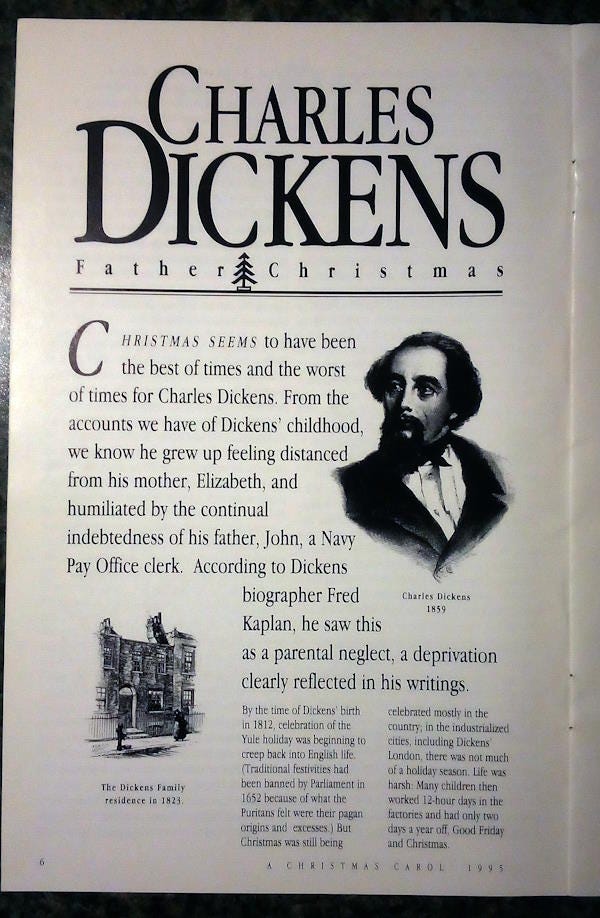
I recall that after he said what he said, I voiced my agreement with him. I also added that it seemed to me the very depth of Scrooge’s descent toward a condition that some might consider irredeemable accounted for the dramatic nature and extent of his redemption when it finally occurred. In other words, he only “snapped back” with such shocking force and exuberance because of the sheer depth of his fall. Mr. Astin nodded, appearing pleased with my words. Today, I can still vividly remember how strange, in an almost giddy way, it felt to be standing there in that particular environment, holding that particular conversation with that particular man.
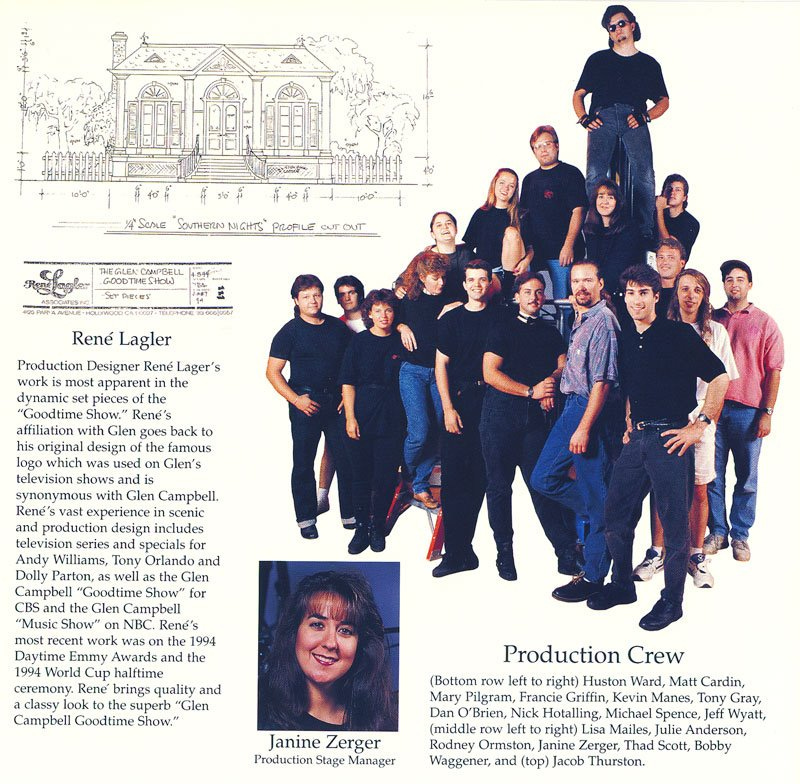
At the play’s next performance on the following evening, when the moment came for Scrooge to leave the scene temporarily and hide behind the piece of scenery that I had moved into position, Mr. Astin took his place back there beside me in the shadows as usual. But this time, he paused to look directly at me, giving me a warm little smile and a nod of silent greeting. I smiled and nodded in return, feeling a warm glow.
And then the show went on.
Warm regards,
Chris Kaltenbach, “Tickled to Death Scrooge: Far from despising Gomez Addams as the character who pigeonholed him, John Astin is thankful for that ghost of TV seasons past,” The Baltimore Sun, December 11, 1995.
More specifically, he practices Nichiren Buddhism, a branch of Mahayana Buddhism that has attracted quite a few celebrity followers, including Patrick Swayze, Tina Turner, Orlando Bloom, and Chow Yun-Fat.


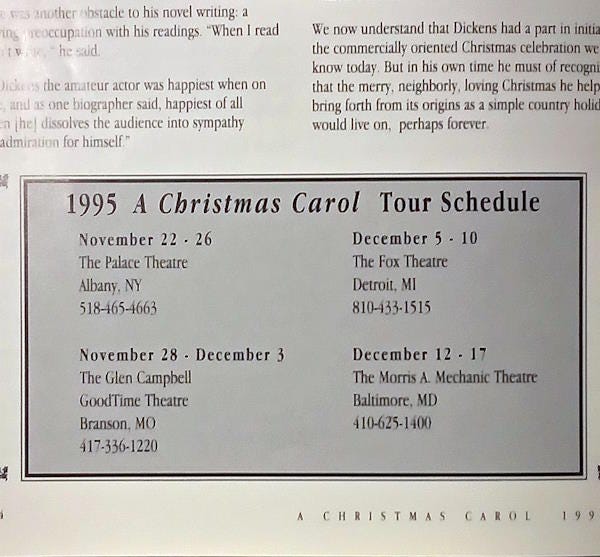

Loved this, Matt, and hopefully the internet is correct, and John Astin is still with us at 94. Bless his dear, aged heart. Btw, you look about 16 yrs old in that crew photo. 😸
Roshi Daniel Doen Silberberg does an annual CC teisho. The local, regionally well known UU minister Douglas Tailor also does an annual sermon. I've been a fan since the depths of the 70s and I wholeheartedly agree and endorse this substack!